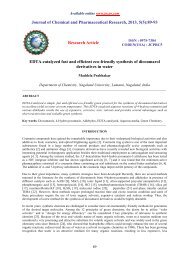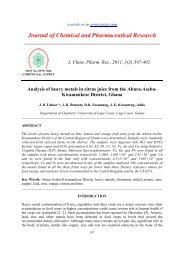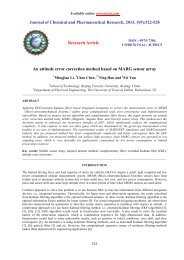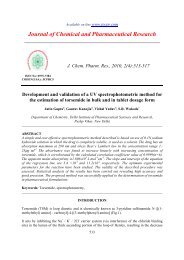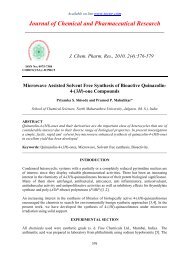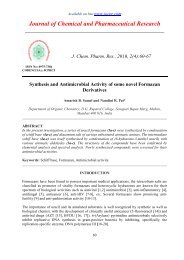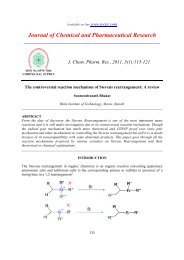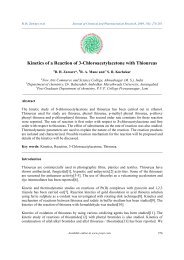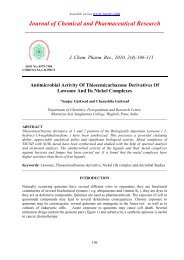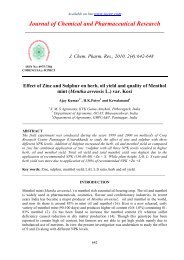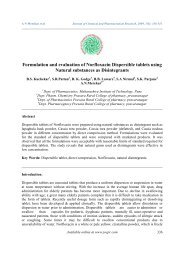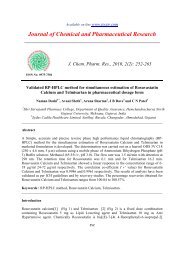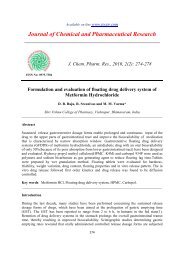Three analytical methods for determination of Epinastine ...
Three analytical methods for determination of Epinastine ...
Three analytical methods for determination of Epinastine ...
You also want an ePaper? Increase the reach of your titles
YUMPU automatically turns print PDFs into web optimized ePapers that Google loves.
Available online www.jocpr.comJournal <strong>of</strong> Chemical and Pharmaceutical Research, 2012, 4(2):1361-1369Research ArticleISSN : 0975-7384CODEN(USA) : JCPRC5<strong>Three</strong> <strong>analytical</strong> <strong>methods</strong> <strong>for</strong> <strong>determination</strong> <strong>of</strong> <strong>Epinastine</strong> hydrochloride inbulk and in ophthalmic solutionsRamzia I. El-Bagary 1 , Amal Boshra 2 , Maha M. El-Hakeem 1 , Amira M. Abdelra’o<strong>of</strong> 21 Pharmaceutical Chemistry Department, Faculty <strong>of</strong> Pharmacy, Cairo University, Kasr El-AiniSt., Cairo, Egypt2 National Organization <strong>of</strong> Drug Research and Control NODCAR, Giza, Egypt______________________________________________________________________________ABSTRACT<strong>Three</strong> simple and sensitive <strong>methods</strong>, namely, difference spectrophotometric, colorimetric and HPLC <strong>methods</strong> aredescribed <strong>for</strong> the <strong>determination</strong> <strong>of</strong> epinastine hydrochloride (EPH) in pure <strong>for</strong>m and ophthalmic solution. First, thedrug is determined quantitatively by pH-induced difference spectrophotometry. The method is based on themeasurement <strong>of</strong> the difference absorbance at 252nm <strong>of</strong> epinastine hydrochloride (EPH) in 0.1N NaOH againstequivalent amount in 0.1N HCl as a blank. Beer's law was obeyed <strong>for</strong> the studied drug over the range <strong>of</strong> 16 to 96µg.ml -1 . In the second method, the drug is converted to its corresponding free base which is treated with chloranilicacid (CAA) solution in acetonitrile to give a colored product with an absorption maximum at 517 nm. Variousexperimental parameters and the stoichiometry <strong>of</strong> the reaction were investigated and optimized. Linearity is obeyedover the range <strong>of</strong> 20-220 µg.ml -1 . The third is an HPLC method, which is developed <strong>for</strong> the <strong>determination</strong> <strong>of</strong> EPHusing acetonitrile: 0.1 M ammonium acetate buffer (40:60 v/v) as a mobile phase at a flow rate 1 ml/min and UVdetection at 262nm. Methyl paraben was used as internal standard. The linearity range was from 20 to 100 µg.ml -1 .The proposed <strong>methods</strong> were validated according to the guidelines <strong>of</strong> the ICH and were also statistically comparedwith the reference method showing no significant difference concerning accuracy and precision.Keywords: <strong>Epinastine</strong> hydrochloride, difference spectrophotometry, chloranilic acid, HPLC, ophthalmic solution.______________________________________________________________________________INTRODUCTION<strong>Epinastine</strong> hydrochloride EPH, chemically known as, 3-Amino-9, 13b-dihydro-1H-dibenz[c,f]imidazo[1,5-a]azepinehydrochloride [1] is a new drug used <strong>for</strong> the prevention <strong>of</strong> itching associated with allergic conjunctivitis. It has amulti-action effect that inhibits the allergic response in three ways: firstly it stabilizes mast cells by preventing mastcell degranulation to control the allergic response, secondly it prevents histamine binding to both the H 1 and H 2receptors to stop itching and provide lasting protection, and finally it prevents the release <strong>of</strong> proinflammatorychemical mediators from the blood vessel to halt progression <strong>of</strong> the allergic response.1361
Ramzia I. El-Bagary et al J. Chem. Pharm. Res., 2012, 4(2):1361-1369______________________________________________________________________________Few <strong>analytical</strong> <strong>methods</strong> were reported <strong>for</strong> the estimation <strong>of</strong> epinastine hydrochloride including HPLC [2,3,and4] andderivative spectrophotometry [4] while epinastine hydrobromide was quantitatively assayed by potentiometricmethod [5].The present study describes two spectrophotometric <strong>methods</strong>, namely difference spectrophotometry and colorimetry,in addition to HPLC method <strong>for</strong> the estimation <strong>of</strong> epinastine hydrochloride (EPH) in bulk and in its pharmaceutical<strong>for</strong>mulation.EXPERIMENTAL SECTION2.1. Instrumentation:For difference method: analysis was carried out on a Shimadzu 1650 PC (Japan) double beam uv-visspectrophotometer connected to IBM compatible computer and HP laser jet 1018 printer. The s<strong>of</strong>tware used wasUVPC personal spectroscopy s<strong>of</strong>tware version 3.7(Shimadzu) with matched quartz cells <strong>of</strong> 1 cm path length .Thespectral band width was 2nm and the wavelength scanning speed was fast.For colorimetric method: measurements were per<strong>for</strong>med using Labomed spectro UV-Vis double beam, scanningauto cell, labomed INC(USA), serial number 001168.For HPLC: a chromatographic system consisting <strong>of</strong> Agilent 1100 HPLC instrument, consisting <strong>of</strong> isocratic pump, anultraviolet variable wavelength detector, an autosampler injector, lichrocart 10 µm C18 column (250 mm×4.6mm),degasser G1322A (S.N.JP05034185), quaternary pump G1311A (S.N.DE14919061), ALS G1313A,(S.N.DE14919455), Col Com G1316A (S.N.DE14928048), VWD G1314A(S.N.JP20217955).2.2. Standards and reagents:All chemicals and reagents used were <strong>of</strong> <strong>analytical</strong> or HPLC grade.<strong>Epinastine</strong> hydrochloride EPH was kindly supplied by Allergan Company (purity 100.31% by HPLC referencemethod ) [6]. Relestat eye drops (0.5mg/ml) (Batch No. E54531), manufactured by Allergen Company waspurchased from the market. Each ml contains 0.5 mg <strong>Epinastine</strong> HCl. Chloranilic acid solution CAA in acetonitrile(1800 µg.ml -1 ) (Sigma-Aldrich), Methanol HPLC grade(lab scan), HCl (0.1N in distilled water), NaOH (0.1N indistilled water), acetonitrile HPLC grade(lab scan), Na 2 CO 3 solution (10%in distilled water), chloro<strong>for</strong>m HPLCgrade, ammonium acetate (0.1 M in distilled water), methylparaben supplied by Pharonia company( purity 98.42%)[7] as internal standard <strong>for</strong> HPLC method.2.3. Chromatographic conditions:Chromatographic separation was carried out on C18 column lichrocart 10 µm (250 mm×4.6mm). Isocratic elutionwas carried out using acetonitrile: 0.1M ammonium acetate buffer (40:60 v/v) at a flow rate 1 ml/min and uvdetection at 262nm. The injection volume was 20 µl. The column was maintained at ambient temperature. Themobile phase was filtered through 0.45µm Teflon membrane filter and degassed <strong>for</strong> about 15 min in ultrasonic bathprior to use. To reach good equilibrium , the analysis was per<strong>for</strong>med after passing about 50-60ml <strong>of</strong> the mobilephase, just <strong>for</strong> conditioning and pre-washing <strong>of</strong> the stationary phase.2.4. Preparation <strong>of</strong> standard stock solutions:a-For difference method: A stock standard solution <strong>of</strong> EPH (0.4mg. ml -1 ) in methanol was prepared.b-For colorimetric method: An accurate weight <strong>of</strong> EPH ( 50mg) was dissolved in distilled water in a 50mlmeasuring flask and transferred into a separating funnel, where 25ml <strong>of</strong> 10%Na 2 CO 3 solution were added. Themixture was mixed and extracted three times each with 25ml CHCl 3 , then the chloro<strong>for</strong>mic layer was evaporated todryness where the obtained residue was dissolved quantitatively in 50ml methanol (final conc. 1mg. ml -1 ).c- For HPLC method: EPH standard stock solution (1 mg .ml -1 ) in methanol and methyl paraben (0.1 mg. ml -1 ) inmethanol as internal standard stock solution.2.5. General procedure and Linearity:a-For difference method:Working standard solutions with concentration ranging from (16- 96 µg.ml -1 ) were prepared by transferringappropriate volumes <strong>of</strong> EPH standard stock solution into two series <strong>of</strong> 5 ml volumetric flasks in duplicate. The1362
Ramzia I. El-Bagary et al J. Chem. Pharm. Res., 2012, 4(2):1361-1369______________________________________________________________________________volume <strong>of</strong> each flask in the first series was adjusted with 0.1N HCl and <strong>for</strong> the second series was adjusted with0.1N NaOH to give two series <strong>of</strong> equimolar solutions <strong>of</strong> EPH in two different pH media.Difference spectra were obtained by scanning the acidic solution (in 0.1N HCl) in the reference cell and the basicsolution (in 0.1N NaOH) in the sample cell. The values <strong>of</strong> absorbance difference at 252 nm were recorded andplotted versus the corresponding concentrations (µg. ml -1 ) <strong>of</strong> the drug to construct the calibration curve and toobtain the regression equation (1)which is stated in Table (2).b- For colorimetric method:Preparation <strong>of</strong> working standard solutions ranging from (20 to 220 µg.ml -1 ) <strong>of</strong> EPH was carried out by introducingaccurately measured aliquots equivalent to (0.1-1.1mg)<strong>of</strong> EPH from its standard stock solution (1mg.ml -1 ) into aseries <strong>of</strong> 5 ml volumetric flasks, followed by 1ml <strong>of</strong> CAA solution then the volume was completed with acetonitrileand mixed well. The absorbance at 517nm <strong>of</strong> the observed color were recorded <strong>for</strong> each flask against itscorresponding blank and plotted versus the corresponding concentrations(µg. ml -1 ) <strong>of</strong> the drug to construct thecalibration curve and to obtain the regression equation (2)which is stated in Table (2).c-For HPLC method:Appropriate aliquots <strong>of</strong> EPH standard stock solution (1 mg.ml -1 ) were transferred into a series <strong>of</strong> 10 ml volumetricflasks, 0.1 ml <strong>of</strong> methyl paraben internal standard solution was added to each flask , then the volume <strong>of</strong> each flaskwas diluted with methanol to obtain working standard solutions ranging from (20-100 mg.ml -1 ).Twenty µl triplicate injections <strong>of</strong> each working standard solution were injected into the chromatographic systemusing a lichrocart 10 µm C18 column.The elution was carried out using acetonitrile: 0.1M ammonium acetate buffer (40:60 v/v) at a flow rate 1 ml/minand uv detection at 262nm.The chromatograms were developed and the ratios <strong>of</strong> the peak areas <strong>of</strong> EPH to those <strong>of</strong> internal standard wererecorded <strong>for</strong> each concentration <strong>of</strong> drug solution. The calibration graph was obtained by plotting the relative peakarea ratios versus the corresponding concentrations (µg. ml -1 ) <strong>of</strong> the drug to construct the calibration curve and toobtain the regression equation (3) which is stated in Table (2).2.6. Determination <strong>of</strong> EPH in “Relestat” eye drops:a-Difference method:Four ml aliquot <strong>of</strong> the eye drop solution (containing 2000µg <strong>of</strong> EPH) was diluted with methanol in a 10 mlvolumetric flask to get a final concentration <strong>of</strong> 200µg.ml -1 . Different aliquots equivalent to (30-70 µg.ml -1 ) weretreated as previously mentioned under general procedure and linearity.The same procedure was repeated applying the standard addition technique. The absorbance difference (∆A) at252nm were used to calculate the concentration <strong>of</strong> eye drops solution and the added authentic using eq.(1).b-For colorimetric method:Twenty ml aliquot <strong>of</strong> ”Relestat” eye drops was shaken in a separating funnel with 10 ml <strong>of</strong> 10% Na 2 CO 3 solutionthen extracted three times each with 25 ml <strong>of</strong> chloro<strong>for</strong>m. The collected chloro<strong>for</strong>mic extracts were evaporated andthe residue was dissolved quantitatively in methanol to 10 ml volume (final concentration 1 mg.ml -1 ). Differentaliquots equivalent to (20-140 µg.ml -1 ) were treated as previously mentioned under general procedure and linearity.The same procedure was repeated applying the standard addition technique. The absorbance at 517nm was used tocalculate the concentration <strong>of</strong> eye drops solution and the added authentic using eq.(2).c-For HPLC method:An aliquot <strong>of</strong> the eye drop solution was diluted with methanol to get a solution <strong>of</strong> 1 mg. ml -1 <strong>of</strong> EPH. Differentaliquots equivalent to (20-70 µg.ml -1 ) were treated as previously mentioned under general procedure and linearity.The same procedure was repeated applying the standard addition technique. The detection at 262nm was used tocalculate the concentration <strong>of</strong> eye drops solution and the added authentic using eq.(3).1363
Ramzia I. El-Bagary et al J. Chem. Pharm. Res., 2012, 4(2):1361-1369______________________________________________________________________________Table (1): Optimum assay parameters <strong>for</strong> the three proposed <strong>analytical</strong> <strong>methods</strong> <strong>of</strong> EPHParameters Difference method Colorimetric method HPLC methodInstrumental parameters-Wavelength range: 400-200 nm.-Recording range: 0 to 2.-spectral band width: 2nm-Sampling interval: auto-Wavelength range: 800-200 nm-Ordinate range limit: 0 to 2.-scanning speed: fast-Scanning speed: fastWavelength<strong>of</strong>measurement (nm)252 517 262Optimizedparametersexperimental-Time <strong>of</strong> reaction: 0 min-Stability <strong>of</strong> the color: 30 min-Drug: Reagent volume ratio : 1:6-Solvent used: acetonitrilemethanolmixture.RESULTS AND DISCUSSION-Stationary phase: lichrocart 10 µmC18 column-Flow rate: 1 ml/min-Mobile phase: acetonitrile:0.1 Mammonium acetate buffer(40:60 v/v)3.1. For Difference method:This work describes a simple pH-induced difference spectrophotometric method <strong>for</strong> the <strong>determination</strong> <strong>of</strong> EPH in eyedrops. The absorbance spectra <strong>of</strong> equimolar solutions <strong>of</strong> EPH in 0.1 N HCl and 0.1 N NaOH, are shown in fig. (1).Fig. (1). Absorption spectra <strong>of</strong> equimolar solution <strong>of</strong> EPH (96 µg.ml -1 ) in 0.1 N NaOH alone (____) , in 0.1 NHCl (------) alone and the difference absorption spectrum <strong>of</strong> equimolar solution <strong>of</strong> EPH ( 96µg.ml -1 )in 0.1 NNaOH vs 0.1 N HCl (……….).Fig.(1) shows the difference absorption spectrum <strong>of</strong> EPH solution in 0.1 N NaOH (in sample cell) against itsequimolar solution in 0.1 N HCl (in reference cell) where it was found that measurements <strong>of</strong> absorbance differenceat 252 nm were quantitatively proportional to EPH concentration. A plot <strong>of</strong> absorbance difference values versusEPH concentration was found to be linear over the concentration range <strong>of</strong> (16-96 µg.ml -1 ,r 2 = 0.9994). The limit <strong>of</strong>detection (LOD) and limit <strong>of</strong> quantitation (LOQ) were calculated and described in Table (2). The obtained spectra <strong>of</strong>the eye drops solution were compared to those <strong>of</strong> the standard drug where both spectra were found to be identical.Difference spectrophotometric method was applied to estimate the concentration <strong>of</strong> EPH in bulk and in“Relestat”eye drops applying the standard addition technique and the obtained results were recorded in Tables (3,8).3.2. For colorimetric method:EPH solution in methanol shows an absorption band at 262 nm as shown in Fig. (2) while CAA in acetonitrilesolution gives a prominent peak at 439 nm. However, on reaction <strong>of</strong> both compounds, a new absorption peak is<strong>for</strong>med at 517 nm as shown in Fig. (2) as a result <strong>of</strong> the <strong>for</strong>mation <strong>of</strong> charge-transfer complex. This colorimetricmethod is based on the <strong>determination</strong> <strong>of</strong> EPH through the <strong>for</strong>mation <strong>of</strong> a charge-transfer complex betweenchloranilic acid which reacts as a Π -acceptor and the studied drug as n-donor in an (acetonitrile-methanol mixture)as shown in Fig.(3). EPH contains two aromatic rings that serve as n-electron donor moieties.1364
Ramzia I. El-Bagary et al J. Chem. Pharm. Res., 2012, 4(2):1361-1369______________________________________________________________________________Fig.(2)Absorption spectra <strong>of</strong> EPH in methanol (20 µg.ml -1 ) ( ______), CAA solution in aceotnitrile (360 µg.ml -1 ) (--------) , and CT complex in methanol-acetonitrile mixture (……….)..The proposed scheme <strong>of</strong> reaction is as follows.Fig.(3): The proposed scheme <strong>of</strong> reaction .The choice <strong>of</strong> solvent, the stability <strong>of</strong> the complexes <strong>for</strong>med and other various experimental parameters wereinvestigated. The stoichiometry <strong>of</strong> the reaction was studied by Job's method <strong>of</strong> continuous variation [8] and it wasrevealed that the interaction occurs in the mole ratio <strong>of</strong> 1:4 (donor: acceptor).CAA solution in various solvents failed to give quantitative results. However, CAA in acetonitrile reactedstoichiometrically <strong>for</strong>ming a purple chloranilic acid radical anion. Acetonitrile proved to be the most suitablediluting solvent as it gives good solvating capacity <strong>for</strong> CAA, and gives the highest yield <strong>of</strong> the radical anion. Othersolvents such as chloro<strong>for</strong>m, 2-propanol, methanol, ethanol were tried and found to be not suitable, because thecomplex <strong>for</strong>med in these solvents either had low absorbance or was precipitated on dilution. The optimum volumeratio <strong>of</strong> drug: reagent <strong>for</strong> complete reaction was found to be 1:6. The reaction between the drug and CAA inacetonitrile was instantaneous and the product remained stable <strong>for</strong> at least 30 minutes. The optimized parameters arelisted in Table (1).3.3. For HPLC method:HPLC has become a widely used tool <strong>for</strong> the routine analysis and separation <strong>of</strong> drugs either alone in pure <strong>for</strong>m [9],or in admixture with other drugs [10,11] or degradation products [11-13] and in pharmaceutical <strong>for</strong>mulations [9-13].Different types <strong>of</strong> stationary phase columns such as C8 and C18 columns with different dimensions and particlesizes were tried <strong>for</strong> example, Agilent C8 zorbax, Agilent C18 zorbax, Agilent C8 Eclipse and Agilent C18 Eclipsecolumns, to obtain the best stationary-mobile phase match. It was clearly found that C18 Lichrocart showed the mostsuitable resolution <strong>for</strong> quantification <strong>of</strong> EPH and its internal standard.Different mobile phases with different buffers and organic modifiers including acetonitrile and methanol have beentested <strong>for</strong> optimizing the HPLC separation. The mobile phase selection was based on peak parameters (symmetry,tailing), run time, ease <strong>of</strong> preparation and cost. It was found that the mobile phase consisting <strong>of</strong> 0.1M ammoniumacetate: acetonitrile in the ratio <strong>of</strong> 60:40 flowing at 1ml/min was quite satisfactory <strong>for</strong> the good resolution and<strong>determination</strong> <strong>of</strong> the studied drug in the presence <strong>of</strong> the internal standard. Any decrease in the ratio <strong>of</strong> ammoniumacetate buffer or increase in flow rate leads to bad resolution between peaks.1365
Ramzia I. El-Bagary et al J. Chem. Pharm. Res., 2012, 4(2):1361-1369______________________________________________________________________________For the <strong>determination</strong> <strong>of</strong> the optimum UV detector wavelength, variable wavelength values were set <strong>for</strong> detection <strong>of</strong>the eluted drug and its internal standard. The optimum wavelength with ideal sensitivity and low noise was found tobe 262 nm .An accurate aliquot (0.2 ml) <strong>of</strong> EPH standard stock solution was transferred into a 10 ml volumetric flask followedby 0.1 ml <strong>of</strong> methylparaben standard tock solution then the volume was completed with methanol. When 20 µlaliquot <strong>of</strong> this mixture solution was subjected to the previously mentioned chromatographic conditions, a typicalchromatogram <strong>of</strong> both compounds in Fig (4) showing well resolved peaks <strong>of</strong> EPH at 4.004 min and its internalstandard at 5.309 min. The total run time <strong>for</strong> a complete quantification <strong>of</strong> the drug and its internal standard wasabout 6.5 min.Fig.(4): HPLC chromatogram <strong>of</strong> EPH (20 µg.ml -1 ) and methyl paraben (1 µg.ml -1 )3.4.Method validation :The proposed <strong>methods</strong> <strong>of</strong> analysis were validated as per the recommendations <strong>of</strong> ICH (IQ1,IQ2)[14] <strong>for</strong> theparameters like accuracy, linearity, precision, specificity, detection limit and quantitation limit. The regressionanalysis <strong>for</strong> the three proposed <strong>methods</strong> using the method <strong>of</strong> least squares was applied <strong>for</strong> the slope (a) and theintercept (b) where results are summarized in Table (2).Table (2): Method validation and <strong>analytical</strong> parameters obtained by the proposed <strong>methods</strong>Parameters Difference method Colorimetric method HPLC methodLinearity range (µg.ml -1 ) 16-96 20-220 20-100Regression equation *:Intercept (a)Slope (b)Y=0.0096X-0.0191 Eq.(1)-0.01910.0096Y=0.0046X+0.0257 Eq.(2)+0.0257.0.0046Y=0.0249X-0.0221 Eq.(3)-0.0221.0.0249Limit <strong>of</strong> detection (LOD) 1.31 3.25 0.76Limit <strong>of</strong> quantitation(LOQ) 3.96 9.84 2.32SD <strong>of</strong> slope S b 0.000061 0.0000082 0.0000226SD <strong>of</strong> intercept S a 0.0038 0.004528 0.0576444Correlation coefficient, r 0.9994 0.9992 0.9998Confidence limit <strong>of</strong> intercept ** -0.0191±0.008103 0.0257±0.009645 0.0221±0.122782Confidence limit <strong>of</strong> slope ** 0.0096±0.0001299 0.0046±0.0000174 0.0249±0.000048* is regression equation: Y= a + bX , where Y is the measured response , X is the concentration <strong>of</strong> the drug (µg.ml -1 )**95% confidence level.3.4.1.Linearity and Range:Linearity was established by per<strong>for</strong>ming the proposed <strong>methods</strong> using a minimum <strong>of</strong> six concentrations on threedifferent days. Linear relationships were observed over the concentration ranges <strong>of</strong> EPH stated in Table (2).3.4.2. Accuracy & Precision:Accuracy <strong>of</strong> the <strong>methods</strong> was determined by per<strong>for</strong>ming recovery studies via the standard addition technique inwhich pre-analyzed samples were taken and known quantities <strong>of</strong> standard EPH were added. Results are shown inTable (3).Interday & Intraday precisions were per<strong>for</strong>med at three concentrations levels (32, 64, 96 µg.ml -1 ) <strong>for</strong> differencemethod, (40,100,160 µg.ml -1 )<strong>for</strong> colorimetric method and (30,50,70 µg.ml -1 ) <strong>for</strong> HPLC analysis. The <strong>determination</strong>s1366
Ramzia I. El-Bagary et al J. Chem. Pharm. Res., 2012, 4(2):1361-1369______________________________________________________________________________were repeated three times in a day and on three different days at each concentration level as shown in tabulatedresults in Tables (4-6).Table (3): Results <strong>of</strong> <strong>determination</strong> <strong>of</strong> EPH in “Relestat” eyedropsParametersDifference method Colorimetric method HPLC methodLabeled amount Added standard Labeled amount Labeled amount Added standard Labeled amountMean 99.94 99.61 99.47 100.46 98.90 99.98±SD 0.73 1.19 1.09 1.26 0.80 1.12± SE 0.37 0.42 0.54 0.36 0.40 0.35RSD% 0.73 1.20 1.09 1.25 0.80 1.12Table (4): Assessment <strong>of</strong> accuracy and repeatability <strong>of</strong> the difference methodConcentration <strong>of</strong>Day 1* Day 2* Day 3* Interday statisticsEPHMeanMeanMeanMean(µg.ml -1 RSD%RSD%RSD%) recovery%recovery%recovery%recovery%RSD%32 101.37 0.12 101.40 0.08 101.33 0.07 101.37 0.0964 99.28 0.05 99.53 0.05 100.16 0.05 99.66 0.0596 100.95 0.02 99.56 0.34 100.41 0.23 100.31 0.20*n=3x3=9 , regression equation: Y= 0.0096 X – 0.0191Table (5): Assessment <strong>of</strong> accuracy and repeatability <strong>of</strong> the colorimetric methodConcentration <strong>of</strong>Day 1* Day 2* Day 3* Interday statisticsEPHMeanMeanMeanMean(µg.ml -1 RSD%RSD%RSD%) recovery%recovery%recovery%recovery%40 100.70 0.27 99.08 0.28 99.62 0.00 99.80 0.28100 101.59 1.41 100.93 1.71 99.84 0.21 100.79 1.11160 100.14 0.13 101.94 0.13 101.53 0.00 101.20 0.13*n=3x3=9 , regression equation: Y= 0.0046 X + 0.0257Concentration <strong>of</strong>EPH(µg.ml -1 )Table (6): Assessment <strong>of</strong> accuracy and repeatability <strong>of</strong> the HPLC methodDay 1* Day 2* Day 3* Interday statisticsMeanMeanMeanRSD%RSD%recovery%recovery%recovery%RSD%30 101.22 0.41 101.62 0.16 100.01 0.57 100.95 0.3850 101.37 1.10 100.17 0.76 99.93 0.08 100.49 0.6570 10.75 0.09 100.64 0.70 100.98 0.66 100.79 0.48*n=3x3=9 , regression equation: Y= 0.0249 X – 0.0221Meanrecovery%3.4.3. LOD and LOQThe calculated LOD and LOQ values, listed in Table (2), confirmed good sensitivity <strong>for</strong> the proposed <strong>methods</strong> andconsequently their capability to determine low amounts <strong>of</strong> the investigated drug.3.4.4. System suitability <strong>for</strong> HPLC:System suitability test parameters were calculated under the optimized experimental conditions. EPH and theinternal standard could be successfully eluted in the <strong>for</strong>m <strong>of</strong> symmetrical peaks quite away from each other. Theretention time values <strong>of</strong> the peaks together with other chromatographic parameters are collected in Table (7) .Thetable describes the calculated resolution value(R s ) as well as selectivity factor(α)which insures complete or 100%separation <strong>of</strong> the compounds under investigation. The Tailing factor <strong>of</strong> the drug peak also revealed linear isothermpeak elution without tailing.3.2.5. Specificity <strong>for</strong> HPLC:Specificity is the ability <strong>of</strong> proposed method to accurately measure the analyte response in the presence <strong>of</strong> allpotential sample components. Complete separation and resolution <strong>of</strong> internal standard from EPH with good peakshapes and without any apparent shoulders confirm specificity <strong>of</strong> the method (HPLC chromatogram in Fig (4).1367
Ramzia I. El-Bagary et al J. Chem. Pharm. Res., 2012, 4(2):1361-1369______________________________________________________________________________Moreover, recovery results <strong>of</strong> “Relestat“ eye drops by the proposed <strong>methods</strong> shown in Table (4) indicated theabsence <strong>of</strong> interferences from the commonly encountered pharmaceutical additives in ophthalmic solutions such asbenzalkonium chloride, disodium edetate, sodium chloride, sodium dihydrogen phosphate dihydrate, sodiumhydroxide/hydrochloric acid(to adjust pH).Table (7): System suitability report <strong>of</strong> HPLC methodCompoundCapacityfactor a Selectivity a Tailing factor a Resolution a Number <strong>of</strong> theoretical plates aEPH 1.83 1.51 0.80 6.26 6686Methylparaben 2.76 0.92 9321ReferenceT = 1 <strong>for</strong> a typicalIncrease with efficiency <strong>of</strong> the1-10 acceptable > 1R > 0.8valuesymmetric peakseparation .a is number <strong>of</strong> samples analyzed is threeThe results obtained by the proposed <strong>methods</strong> were statistically compared with reference method concerning (t-test)and (F-test) values showing no significant difference between the proposed <strong>methods</strong> and the reference method asshown in Table (8).Table (8): Statistical analysis <strong>of</strong> the results obtained by the proposed <strong>methods</strong> and the reference HPLCmethod <strong>for</strong> EPH in bulkParameters Difference method Colorimetric method HPLC method Reference method**Mean 100.12 100.91 99.85 100.37± SD 0.74 1.09 0.81 0.86± SE 1.65 0.49 0.33 0.38N 5 5 6 5Variance 2.71 1.20 0.66 0.73“t” value 0.30(1.86)* 0.87(1.86)* 1.03(1.83)*“F” value 3.71(6.39)* 1.64(6.39)* 1.11(5.19)**Figures in parenthesis are the corresponding theoretical t- and F-values at P=0.05**Reference method <strong>for</strong> EPH using HPLC method[6].CONCLUSIONIn this study, difference, colorimetric in addition to HPLC <strong>methods</strong> were developed and validated <strong>for</strong> thequantitative estimation <strong>of</strong> EPH in bulk and in “Relestat”eye drops. There was no interference from additivescommonly found in eye drops dosage <strong>for</strong>ms. The statistical parameters clearly indicate the reproducibility andaccuracy <strong>of</strong> the <strong>methods</strong>. The proposed <strong>methods</strong> were found to be simple, precise and rapid so they could beadapted <strong>for</strong> both quality control and routine <strong>determination</strong> <strong>of</strong> EPH.REFERENCES[1](http://www.medicineonline.com/drugs/e/1552/ELESTAT-epinastine-HCl-ophthalmic-solution-0-05Sterile.html)[2]Saleh ,Ola.A., El-Azzouny, Aida.A., Badawy Amr.M., Aboul-Enein H.Y., Journal <strong>of</strong> Liquid Chromatography &Related Technologies,2010,33(3), 413 - 422 , DOI: 0.1080/10826070903526402[3]Hisakazu Ohtani A., Hajime Kotaki A., Yasufumi Sawada B., Tatsuji Iga A. Journal <strong>of</strong> chromatography B.,1996, 683, 281-284.[4]Daniela Dal Molim Ghisleni, Martin Steppe, Elfrides E.S.Schapoval. Journal <strong>of</strong> AOAC INTERNATIONAL ,2007,90 (5), 1266-1271.Print ISSN: 1060-3271.[5]Mandava V., Basaveswara R., Reddy, B.C.K., Srinivas Rao, T. and Kalyani P. RASAYAN J. Chem.http://www.rasayanjournal.com, 2009,2(2), 361-363, ISSN: 0974-1496 , CODEN: RJCABP.[6] Raw Material in house specifications, Allergan pharmaceuticals, (HPLC procedure).[7] Raw Material in house specifications, Pharonia pharmaceuticals, (HPLC procedure).[8] J. Rose. Advanced Physico-Chemical Experiments", Pitman, London, 1964; 54.[9] N.M. Rao, J. Bagyalakshmi and T. K. Ravi, J.Chem.Pharm.Res.,2010, 2(2), 350-356.[10] R. I. El-Bagary, E. F. Elkady and A. J. Faqeh, J.Chem.Pharm.Res.,2011, 3(6), 320-329.1368
Ramzia I. El-Bagary et al J. Chem. Pharm. Res., 2012, 4(2):1361-1369______________________________________________________________________________[11] U.M. Patel and R. N. Rao. J.Chem.Pharm.Res.,2011, 3(6), 200-211.[12] B.A. Moussa; R.I. El-Bagary; Y.A. Al-Eryani. J.Chem.Pharm.Res.,2011, 3(5), 425-437.[13] S.T.Hassib; A.A. El-Zaher; M.A. Fouad. J.Chem.Pharm.Res., 2011, 3(6), 243-258.[14](ICH (IQ1,IQ2 ))- ICH Q2B, Harmonized Tripartite Guideline, Validation <strong>of</strong> Analytical procedure:Methodology, IFPMA, in: Proceedings <strong>of</strong> the International Conference on Harmonization, Genevrch, March 1996.1369



